Hulunbuir
Hulunbuir or Hulun Buir (Mongolian: ![]()
Hulunbuir 呼伦贝尔市 • ᠬᠥᠯᠥᠨ ᠪᠤᠶᠢᠷ ᠬᠣᠲᠠ | |
|---|---|
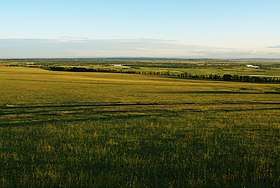 Hulunbuir steppes | |
.svg.png) Location of Hulunbuir City jurisdiction in Inner Mongolia | |
 Hulunbuir Location of the city centre (Hailar) in Inner Mongolia | |
| Coordinates (Hulunbuir municipal government): 49°12′26″N 119°46′16″E | |
| Country | People's Republic of China |
| Region | Inner Mongolia |
| Municipal seat | Hailar District |
| Area | |
| • Prefecture-level city | 263,953 km2 (101,913 sq mi) |
| • Urban (2017)[1] | 252.00 km2 (97.30 sq mi) |
| • Districts[1] | 1,518.9 km2 (586.5 sq mi) |
| Population (2010) | |
| • Prefecture-level city | 2,549,278 |
| • Density | 9.7/km2 (25/sq mi) |
| • Urban (2017)[1] | 349,400 |
| • Urban density | 1,400/km2 (3,600/sq mi) |
| • Districts[1] | 356,000 |
| • Major nationalities | Han: 81.85% Mongols: 8.6% Manchu: 4.13% |
| Time zone | UTC+8 (China Standard) |
| Postal code | 021000 |
| Area code(s) | 0470 |
| ISO 3166 code | CN-NM-07 |
| Website | www |
| Hulunbuir | |||||||||
|---|---|---|---|---|---|---|---|---|---|
| Chinese name | |||||||||
| Simplified Chinese | 呼伦贝尔 | ||||||||
| Traditional Chinese | 呼倫貝爾 | ||||||||
| |||||||||
| Mongolian name | |||||||||
| Mongolian Cyrillic | Хөлөнбуйр хот | ||||||||
| Mongolian script | ᠬᠥᠯᠥᠨ ᠪᠤᠶᠢᠷ ᠬᠣᠲᠠ | ||||||||
| |||||||||
History
During the Qing Dynasty (1644–1912), Hulunbuir was part of Heilongjiang province. The 1858 Treaty of Aigun established today's approximate Sino-Russian border, at a great loss to Heilongjiang's territory. In 1901, the Chinese Eastern Railway linked Hulunbuir to the rest of northeast China and to Russian Far East. From 1912–1949, during the Republic of China (ROC) period, Hulunbuir was part of Xing'an and Heilongjiang provinces. A treaty between the Russian Empire and the ROC on November 7/October 24, 1915 designated Hulunbuir a "special" region under direct subordination to the Central Government of China, but in practice Russia had partial control over day-to-day administration. In 1929, the Soviet Union broke this agreement and invaded Hulunbuir.[2] After the Japanese invasion of China, Hulunbuir became part of the Japanese puppet state Manchukuo, which was not recognized by the Chinese. In the Chinese Civil War, the Communist Party of China gained the support of Inner Mongol leaders like Ulanhu by promising the irredentist expansion of Inner Mongolia into areas that had majorities of Han and Manchu peoples.[3]
After the 1949 Communist revolution, Hulunbuir was annexed into Inner Mongolia, but the region kept economic ties to the rest of the northeast via the Chinese Eastern Railway.[4] During the Cultural Revolution, the parts of historical Manchuria inside Inner Mongolia were briefly restored to their original provinces; Hulunbuir was given back to Heilongjiang from 1969 to 1979.[4] Until October 10, 2001, Hulunbuir was administered as a League. The area is 263,953 km2 (101,913 sq mi) and had a population of 2.710 million in 2004, while the gross domestic product was RMB 21.326 billion. The jurisdiction area of the city is larger than all but 8 Chinese province-level divisions (and 42 U.S. states), although the actual urban agglomeration is just a very small part of the region, and the average population density of the area is very low.
Names
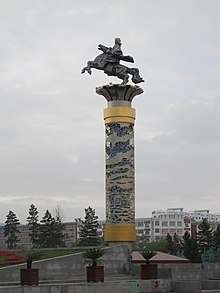
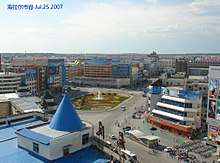
The city was once a league (盟) of Inner Mongolia, until 10 October 2001. During the Qing Dynasty, it was known in Mandarin as Hūlúnbùyǔ'ěr (simplified Chinese: 呼伦布雨尔; traditional Chinese: 呼倫布雨爾).
Administrative subdivisions
Hulunbuir is divided into 13 different county-level jurisdictions: one district, five county-level cities, four banners and three autonomous banners.
| Map | ||||||
|---|---|---|---|---|---|---|
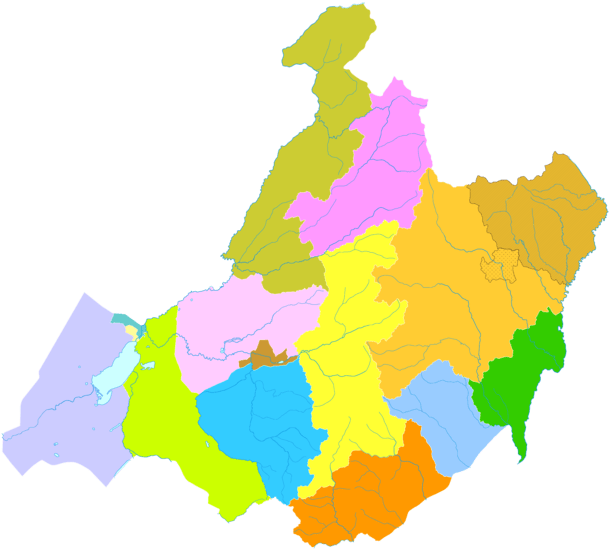 Old Barag
Banner Ergun
(city) 1. Jalainur
Note: Jiagedaqi & Songling
is de facto part of Oroqen Banner but subordinate to Daxing'anling Prefecture in Heilongjiang. | ||||||
| Name | Mongolian | Hanzi | Hanyu Pinyin | Population (2010) |
Area (km²) | Density (/km²) |
| Hailar District | ᠬᠠᠶᠢᠯᠠᠷ ᠲᠣᠭᠣᠷᠢᠭ (Qayilar toɣoriɣ) |
海拉尔区 | Hǎilā'ěr Qū | 344,947 | 1,440 | 181 |
| Jalainur District | ᠵᠠᠯᠠᠢᠳᠨᠠᠭᠤᠷ ᠲᠣᠭᠣᠷᠢᠭ (Jalainaɣur toɣoriɣ) |
扎赉诺尔区 | Zhālàinuò'ěr Qū | 97,000 | 272 | 357 |
| Manzhouli City | ᠮᠠᠨᠵᠤᠤᠷ ᠬᠣᠲᠠ (Manjuur qota) |
满洲里市 | Mǎnzhōulǐ Shì | 152,473 | 424 | 360 |
| Zalantun City | ᠵᠠᠯᠠᠨ ᠠᠶᠢᠯ ᠬᠣᠲᠠ (Jalan Ayil qota) |
扎兰屯市 | Zhālántún Shì | 366,326 | 16,800 | 21.8 |
| Yakeshi City | ᠶᠠᠭᠰᠢ ᠬᠣᠲᠠ (Yaɣsi qota) |
牙克石市 | Yákèshí Shì | 352,177 | 27,590 | 12.8 |
| Genhe City (Gengol City) |
ᠭᠡᠭᠡᠨ ᠭᠣᠣᠯ ᠬᠣᠲᠠ (Gegen Ɣool qota) |
根河市 | Gēnhé Shì | 110,441 | 19,659 | 5.6 |
| Ergun City | ᠡᠷᠭᠦᠨᠡ ᠬᠣᠲᠠ (Ergün-e qota) |
额尔古纳市 | É'ěrgǔnà Shì | 76,667 | 28,000 | 2.7 |
| Arun Banner | ᠠᠷᠤᠨ ᠬᠣᠰᠢᠭᠤ (Arun qosiɣu) |
阿荣旗 | Āróng Qí | 278,744 | 12,063 | 23.1 |
| New Barag Right Banner (Xin Barag Barun Banner) |
ᠰᠢᠨᠡ ᠪᠠᠷᠭᠤ ᠪᠠᠷᠠᠭᠤᠨ ᠬᠣᠰᠢᠭᠤ (Sin-e Barɣu Baraɣun qosiɣu) |
新巴尔虎右旗 | Xīnbā'ěrhǔ Yòu Qí | 36,356 | 25,102 | 1.4 |
| New Barag Left Banner (Xin Barag Jun Banner) |
ᠰᠢᠨᠡ ᠪᠠᠷᠭᠤ ᠵᠡᠭᠦᠨ ᠬᠣᠰᠢᠭᠤ (Sin-e Barɣu Jegün qosiɣu) |
新巴尔虎左旗 | Xīnbā'ěrhǔ Zuǒ Qí | 40,258 | 22,000 | 1.8 |
| Old Barag Banner (Huqin Barag Banner) |
ᠬᠠᠭᠤᠴᠢᠨ ᠪᠠᠷᠭᠤ ᠬᠣᠰᠢᠭᠤ (Qaɣučin Barɣu qosiɣu) |
陈巴尔虎旗 | Chénbā'ěrhǔ Qí | 58,244 | 21,192 | 2.7 |
| Oroqen Autonomous Banner | ᠣᠷᠴᠣᠨ ᠤ ᠥᠪᠡᠷᠲᠡᠭᠡᠨ ᠵᠠᠰᠠᠬᠤ ᠬᠣᠰᠢᠭᠤ (Orčon-u öbertegen jasaqu qosiɣu) |
鄂伦春自治旗 | Èlúnchūn Zìzhìqí | 223,752 | 59,800 | 3.7 |
| Ewenki Autonomous Banner | ᠡᠸᠡᠩᠬᠢ ᠥᠪᠡᠷᠲᠡᠭᠡᠨ ᠵᠠᠰᠠᠬᠤ ᠬᠣᠰᠢᠭᠤ (Eveŋki öbertegen jasaqu qosiɣu) |
鄂温克族自治旗 | Èwēnkèzú Zìzhìqí | 134,981 | 19,111 | 7.1 |
| Morin Dawa Daur Autonomous Banner | ᠮᠣᠷᠢᠨ ᠳᠠᠪᠠᠭᠠ ᠳᠠᠭᠤᠷ ᠥᠪᠡᠷᠲᠡᠭᠡᠨ ᠵᠠᠰᠠᠬᠤ ᠬᠣᠰᠢᠭᠤ (Morin Dabaɣ-a Daɣur öbertegen jasaqu qosiɣu) |
莫力达瓦达斡尔族自治旗 | Mòlìdáwǎ Dáwò'ěrzú Zìzhìqí | 276,912 | 10,500 | 26.4 |
| Part of Oroqin Autonomous Banner is de facto subordinate to Daxing'anling Prefecture in Heilongjiang. | ||||||
Geography and climate
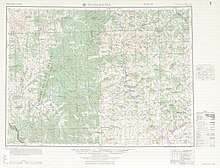

Hulunbuir itself (Hailar) has a humid continental climate (Köppen Dwb). Winters are long, very dry and severe, due to the semi−permanent Siberian High, while summers are short, though very warm, and rather wet, due to the East Asian monsoon. At Hailar, the monthly 24-hour average temperature ranges from −25.1 °C (−13.2 °F) in January to 20.0 °C (68 °F) in July, while the annual mean is −0.96 °C (30.3 °F). With at least 55% of possible sunshine in all months and an annual total greater than 2,700 hours, sunny weather dominates year-round. Approximately 70% of the annual rainfall occurs during the three summer months.
| Climate data for Hailar District (1981−2010 normals) | |||||||||||||
|---|---|---|---|---|---|---|---|---|---|---|---|---|---|
| Month | Jan | Feb | Mar | Apr | May | Jun | Jul | Aug | Sep | Oct | Nov | Dec | Year |
| Average high °C (°F) | −19.2 (−2.6) |
−13.5 (7.7) |
−3.4 (25.9) |
9.5 (49.1) |
18.4 (65.1) |
24.4 (75.9) |
26.1 (79.0) |
24.3 (75.7) |
17.6 (63.7) |
8.0 (46.4) |
−5.8 (21.6) |
−16.2 (2.8) |
5.8 (42.5) |
| Daily mean °C (°F) | −24.8 (−12.6) |
−20.3 (−4.5) |
−9.9 (14.2) |
3.0 (37.4) |
11.6 (52.9) |
18.0 (64.4) |
20.4 (68.7) |
18.3 (64.9) |
10.8 (51.4) |
1.2 (34.2) |
−11.7 (10.9) |
−21.4 (−6.5) |
−0.4 (31.3) |
| Average low °C (°F) | −29.2 (−20.6) |
−25.7 (−14.3) |
−15.8 (3.6) |
−3.0 (26.6) |
4.4 (39.9) |
11.4 (52.5) |
14.9 (58.8) |
12.8 (55.0) |
5.0 (41.0) |
−4.0 (24.8) |
−16.3 (2.7) |
−25.7 (−14.3) |
−5.9 (21.3) |
| Average precipitation mm (inches) | 4.6 (0.18) |
3.6 (0.14) |
6.0 (0.24) |
13.9 (0.55) |
22.7 (0.89) |
55.1 (2.17) |
94.0 (3.70) |
88.0 (3.46) |
33.6 (1.32) |
16.7 (0.66) |
6.4 (0.25) |
7.4 (0.29) |
352.0 (13.86) |
| Average precipitation days (≥ 0.1 mm) | 7.6 | 5.9 | 5.6 | 5.9 | 7.0 | 12.9 | 14.5 | 12.4 | 9.5 | 6.2 | 7.1 | 9.6 | 104.2 |
| Average relative humidity (%) | 78 | 78 | 69 | 52 | 46 | 59 | 69 | 70 | 64 | 62 | 73 | 79 | 67 |
| Mean monthly sunshine hours | 167.0 | 195.6 | 244.1 | 246.2 | 298.0 | 285.9 | 279.8 | 268.7 | 218.6 | 210.1 | 165.3 | 139.4 | 2,718.7 |
| Percent possible sunshine | 63 | 69 | 67 | 60 | 63 | 59 | 58 | 60 | 58 | 63 | 60 | 55 | 61 |
| Source: China Meteorological Administration (precipitation days and sunshine 1971–2000)[5][6] | |||||||||||||
Demographics
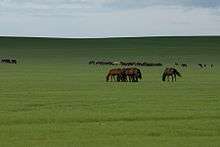
| ethnic group | population in 2000 | share |
|---|---|---|
| Han | 2,199,645 | 81.85% |
| Mongols | 231,276 | 8.6% |
| Daur | 111,053 | 4.13% |
| Hui | 70,287 | 2.62% |
| Evenks | 30,950 | 1.15% |
| Oroqen | 8,355 | 0.31% |
| Russians | 4,741 | 0.18% |
References
- Ministry of Housing and Urban-Rural Development, ed. (2019). China Urban Construction Statistical Yearbook 2017. Beijing: China Statistics Press. p. 46. Retrieved 11 January 2020.
- Tang, Peter SH. "Sino-Soviet Territorial Disputes: Past and Present." Russian Review (1969). p. 406.
- Bulag, Uradyn (2005). "Inner Mongolia". In Rossabi, Morris (ed.). Governing China's Multiethnic Frontiers. University of Washington Press. pp. 90–91.
- Shabad, Theodore (1972). China's Changing Map: National and Regional Development, 1949-71. Taylor & Francis. pp. 237–239.
- 中国气象数据网 - WeatherBk Data (in Chinese). China Meteorological Administration. Retrieved 2020-04-15.
- 中国地面国际交换站气候标准值月值数据集(1971-2000年). China Meteorological Administration. Archived from the original on 2013-09-21. Retrieved 2010-05-25.
Further reading
- 今日内蒙古: 呼伦贝尔 [Inner Mongolia today: Hulun Buir]. Hohhot: Inner Mongolia People's Publishing House. 1997. pp. 9 and 129. ISBN 7-204-03545-3.
- 呼伦贝尔民族文物考古大系:鄂伦春自治旗卷 [Hulunbuir Ethnic Cultural Relics and Archaeology Series. Oroqen Autonomous Banner]. Beijing: Cultural Relics Press. 2014. p. 255. ISBN 9787501039517.
- 呼伦贝尔民族文物考古研究. viii. Beijing: Sciences Press. 2013–2014. pp. 537 and 538. ISBN 9787030393463., -4033.
- Bökecilagu. Kölün Boyir-un sonirqal-ud. Qayilar : Ȯbȯr Mongġol-un Soyol-un Keblel-u̇n Qoriy-a, 1988. 2, 8, 217 p. ISBN 9787805060231.
- Möngkedalai. Hulunbeier samanjiao yu lamajiao shilüe = Kölün Boyir-un böge-yin śasin kiged lama-yin śasin-u tobci teüke. Beijing : Minzu chubanshe, 2014. 5, 4, 545 p., ill., biblio., index. ISBN 9787105130573.
External links
| Wikimedia Commons has media related to Hulunbuir. |
- Hulunbuir government website (in Chinese)
- Inner Mongolian postcodes (in English)